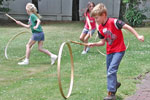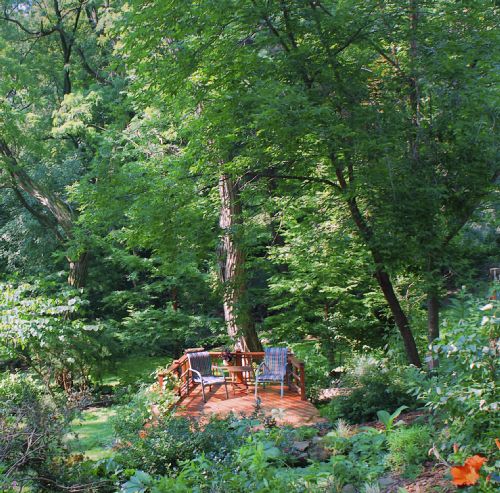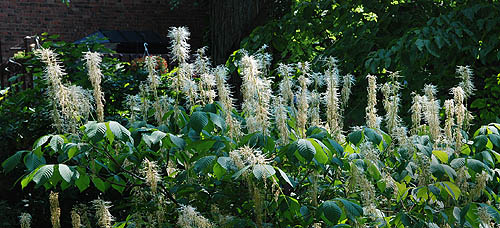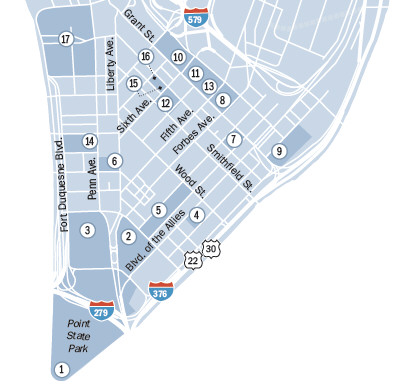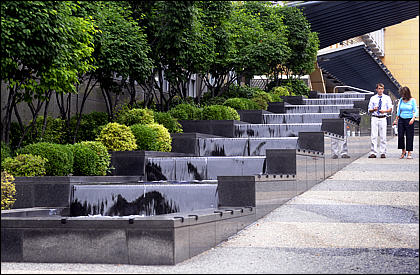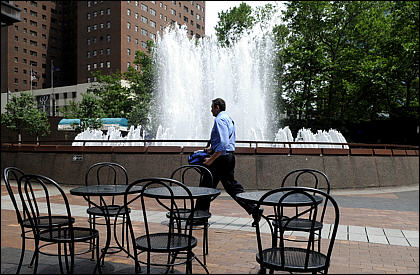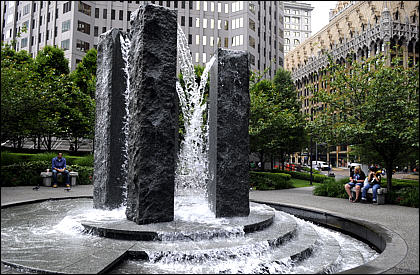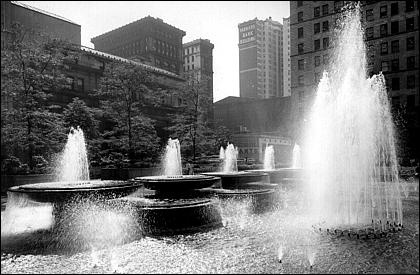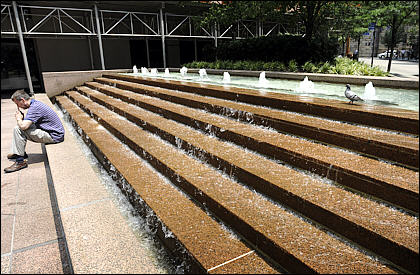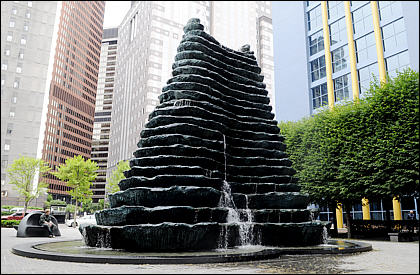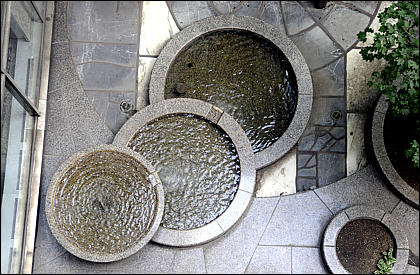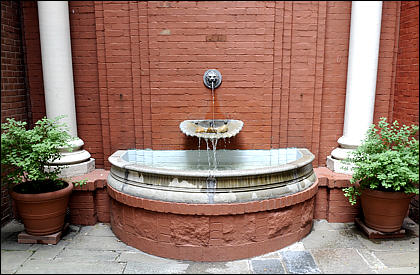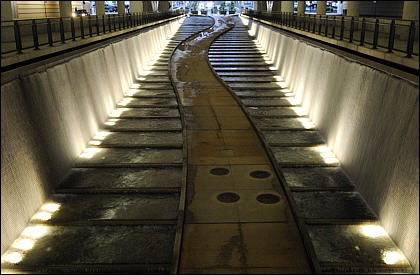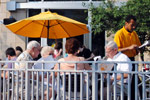
Category Archive: Tours & Events
-
Kids Can Get Hands on With Historical Games at Old Economy Village
By Kellie B. Gormly, PITTSBURGH TRIBUNE-REVIEW
Thursday, July 15, 2010Long before the days of battery-operated Buzz Lightyear toys and Wiis, kids had to get pretty creative in order to make toys and play games.
Children in the 19th century would amuse themselves with activities like rolling hoops with sticks, and doing “Lady Ann’s ring tosses,” which involved a stick tied to a wooden circle about the size of a doughnut. Kids would toss the stick around, and try to catch the circle with it. In another old-fashioned game, quoits, people would throw rings to land around a peg in the ground. Many of the toys were made with scrap wood that came from building houses.
“They had to make their own toys, mostly,” says Lynn Popovich, who is organizing a play-themed event at Old Economy Village this weekend. “You couldn’t go to the store and buy them. … Most of the toys back then were creative things that the parents sort of invented when the kids were little to keep them busy.”
On Saturday, Old Economy Village — which re-opened in April, after a state budget crisis closed the National Historic Landmark for a few months — will let its visitors explore, learn about and try out toys and games from the 1800s, when the Harmonists from Germany settled the Beaver County village. Hands On History Day features the old-fashioned amusements, along with arts and crafts, sack races, a historical scavenger hunt, and more. Kids can get their pictures taken while wearing reproduction 19th-century clothing, attend an 1830s schoolhouse session, watch puppet shows, play old instruments like kazoos, and more.
The activities will allow visitors of all ages to step back in time and enjoy getting a feel for early American life, says Popovich, who is the village’s volunteer coordinator and store manager.
“We just want them to come and have a fun time and experience the days of yore … with their children,” she says. “It’s something for the entire family. There aren’t a lot of activities where kids and parents can enjoy themselves together. They can walk around the garden, pavilion and gazebo, sit on the bench and reflect how people lived back then.
Kids, Popovich says, are “fascinated, I think, with how the children of yesterday lived, without the modern conveniences.”
“They love playing with the old-fashioned toys,” she says. “You wouldn’t think that they’d be interested because they’re so involved with iPods .. and all that high-tech stuff.”
Hands On History Day includes demonstrations from a blacksmith, weaver, broommaker, baker and other artisans, and visitors can try out these activities, Popovich says. The Ambridge Steel Drum Band will be performing at 1 and 3 p.m. Hot dogs, drinks and other snacks will be sold.
During school tours at the village, she says, the kids are fascinated by how their predecessors amused themselves without batteries and electricity.
_______________________________________________________________________________________
Hands On History Day_______________________________________________________________________________________When: 10 a.m.-5 p.m. Saturday
Admission: $9 for age 11-64; $6 for ages 3-11; $8 for age 65 and older; free for age 2 and younger
Where: Old Economy Village, 270 16th St., Ambridge, Beaver County
Details: 724-266-4500 or website
-
Mount Lebanon Gardener Turns Destruction into Opportunity
Saturday, July 10, 2010By Kevin Kirkland, Pittsburgh Post-Gazette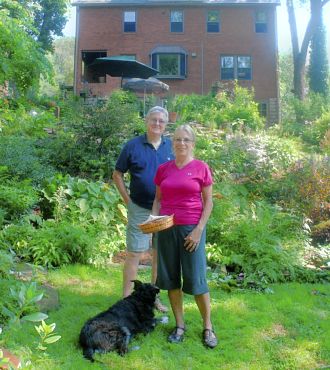
Larry Roberts / Post-Gazette Wes and Nancy Smith will open their garden for the Mt. Lebanon Library's 20th Anniversary Garden Tour.
In more than 25 years of Pittsburgh gardening, Nancy Smith has tested, sometimes fooled and been humbled by Mother Nature.
She has succeeded with plants that supposedly need more sunlight or aren’t supposed to survive our winters. And she has lost perfectly suitable plants and trees to beastly weather, critters big and small and for no earthly reason at all. She tries to see major disasters like falling trees as an opportunity for change.
“It opens something up,” she says.
But the past five months have tested even the most hopeful gardener’s patience.
February’s snowmageddon brought down three large junipers, a chamaecyparis and a Leyland cypress. A great blue heron ate one large koi and more than half of the dozen goldfish in two ponds, and birds and rodents teamed up to steal her entire crop of strawberries. Then, recent high winds brought a neighbor’s 80-foot-tall black locust tree crashing down on a bed between the two ponds.
Despite it all, Mrs. Smith will have her garden looking great for Sunday’s Mt. Lebanon Library Garden Tour. Hers and six other gardens will be open from noon to 5 p.m. You can see more of her handiwork today, when the library holds its garden party in the courtyard that Mrs. Smith and 11 other volunteers have created over the past 10 years.
Everywhere she gardens, Mrs. Smith tries to keep a simple motto in mind:
Destruction is an opportunity for change.
Growing up near Baltimore, she failed in her first attempt at a garden at age 9. She had better luck shortly after she married Wes Smith, another Maryland native. Her parents brought lots of plants from their yard to the rental property the newlyweds shared. They moved to Mt. Lebanon in 1983 and volunteering at the library garden led to classes at what is now Phipps Garden Center. She became a master gardener in 1987 and was one of the leaders in designing and planting the library’s courtyard garden in 2000-01.
Meanwhile, Mrs. Smith was transforming her front and back yard, which once held mostly grass and a pedestrian collection of yews, forsythia, pachysandra and a few large spruce, locust and maple trees. The front still has a little grass nearly hidden by beds packed with interesting cultivars of phlox, sedum, ligularia, boxwood, hydrangea, yellow-leafed caryopteris and other perennials and shrubs. A fast-growing curly willow and red maple provide some shade.
The backyard originally held a concrete patio leading to a grassy hillside. But it soon changed.
“Every year we add something,” Mrs. Smith said.
She adds the plants (she says she’s a reformed “plant hog”) and her husband adds hardscape.
“I build or haul or cut grass,” he said modestly.
One year, Mr. Smith and his two sons-in-law replaced the concrete patio with one made of paver bricks laid in a herringbone pattern. Mrs. Smith created perennial beds around the old brick walls and grill, featuring larkspur, catchfly (Silene armeria), amsonia, New England asters, Joe Pye weed, cleome and an arum with exotic long leaves and giraffe-like spots on its thick stem.
When a willow fell nearby, Mrs, Smith asked her husband to build a pond near the stump. The next year he built a lower pond and linked them with a waterfall. The year the garden was on the Pittsburgh Botanic Garden Tour, he built a deck near the lower pond. He also built a cold frame and all the paths in the backyard.
With each piece of hardscape, Mrs. Smith creates adjoining beds. And as trees or limbs fall, she adds interesting shrubs and trees. She’s planted two metasequoias, a paperbark maple, redbud, fernleaf buckthorn, Carolina silverbell, Virginia juniper, ‘Diablo’ ninebark and a bottlebrush buckeye (Aesculus parviflora) that is just done blooming.
A shady bed near the bottom of the hill features Lenten rose, hostas, goatsbeard, ferns, variegated Solomon’s seal and Allegheny spurge, our native pachysandra.
“I like to do a lot of natives,” Mrs. Smith says, but her garden is not limited to them.
Her advice to gardeners who are just starting is simple: Take classes and talk to other gardeners about plants that do well here. And don’t overdo it.
“You can’t handle more than one new garden per year,” she said. “Otherwise, it’s a full-time job.”
Mt. Lebanon Library’s 20th anniversary Garden Tour runs from noon to 5 p.m. Sunday. The library will have a plant sale and free consultations with Penn State Master Gardeners and a member of the Pittsburgh Rose Society. Tickets are $12 in advance and $15 on tour day at the library. A pre-tour Garden Party will be held from 6 to 8 p.m. today in the library garden courtyard. Tickets are $25 per person and available at the door.
-
Tiny Gardener Designed Her House and Garden to Show Off Beloved Flowers
Saturday, July 10, 2010By Susan Banks, Pittsburgh Post-Gazette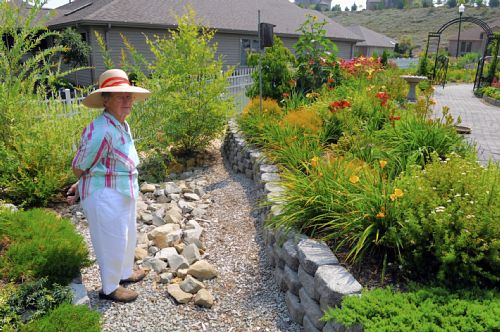
Irene Ciccarelli stands in front of the the willow, birch and pine trees in the catch basin area of her garden in North Huntingdon. Darrell Sapp / Post-Gazette
Overflowing flower beds with lots and lots of color, that’s Irene Ciccarelli’s cup of tea. Her 2-year-old garden, tucked in the new Lincoln Hills housing plan in North Huntingdon, stands out among the restrained landscaping of her neighbors. It’s not that she doesn’t like the neatly manicured plots around her home, she just likes flowers better.
She also likes being able to look out her windows and see flowers, so her garden has been designed to frame the property and be visible from the indoors, with only a small patch of lawn in the front. It’s also designed to be handicapped-accessible in case the energetic 80-year-old ever needs to use a wheelchair to tend it.
In less than two years, this diminutive woman has managed to plan, plant and tend a garden that will be open to visitors today from 10 a.m. to 2 p.m. for the Greenridge Garden Club and Norwin Art League’s 2010 Art in the Garden Tour. Mrs. Ciccarelli’s garden and six others will feature artwork by league members.
Mrs. Ciccarelli, who will be in her garden on the day of the tour, is no stranger to hard work. She recalls hoeing corn during the Depression, and also has fond memories of the flowers that her mother tended at their home in Irwin. The names of those flowers intrigued her and led to her lifelong enthusiasm for plants. This is her fourth garden — she has created three others in different areas of the country where she and her husband lived during their long marriage.
When her husband passed away several years ago, Mrs. Ciccarelli, a retired schoolteacher, moved back here to be closer to family. While staying with her sister, she started looking for a new home that would meet all of her needs. The house she is in now was under construction when she purchased it, allowing her to customize the inside, adding more windows and doors, and also alter the outside hardscape. When moving day came, there was no landscaping, just dirt. She had crummy soil, a drainage ditch and a wickedly steep hillside in the back. In other words, she had a Pittsburgh yard.
She first amended the soil by double-digging the flower beds and adding 10 to 12 truckloads of mushroom manure — by herself. Then planting commenced.
When asked if she had a grand plan, she shrugs and says she made it up as she went along. She did know she wanted continuous color and lots of perennials, which she loves. As inspiration, she used Anne Hathaway’s garden in Shottery, England, considered the quintessential cottage garden. She laughs when she recounts that on a visit to that garden she discovered it takes six or eight full-time gardeners to keep it looking perfectly informal.
Though a neighbor cuts her small patch of grass, Mrs. Ciccarelli tends this garden herself, usually in the early part of the day. The beds are overflowing with coneflowers, bee balm, clematis, heuchera, lady’s mantle, daylilies, liatris, bergenia and more; many are now happily self-sowing. Because she mulches heavily, she hasn’t had to start watering until just this past week.
When asked if she had a favorite nursery, she replied that she buys lots of her plants from the damaged table at Lowe’s. She says it’s a great place to find inexpensive plants that just need a little tender loving care, but she cautions bargain hunters to go early in the morning when the pickings are good.
Sometimes, she’ll splurge on a special specimen such as the Bonica rose planted on a trellis. She found a gate/trellis at a discount store and installed that on the side of the house. Conifers are plopped into the beds to provide winter interest and small ornaments are scattered throughout. Her attention to detail is seen in the garden and in her home, both of which were lavishly decorated for the July Fourth holiday.
Her next big project will be the extremely steep bank behind the house. She has started planting it with shrubs and plans on fencing some of it off to discourage the deer, which invade during the winter.
And while the garden will never be finished, she says, “I’ve accomplished what I set out to do (two years ago). I have year-round color.”
Tickets for the Art in the Garden Tour are $10 and can be purchased at Vargos Hallmark Shops, Norwin Town Square and Norwin Hills Shopping Center; Belaks Flower Shop in Irwin and the Greensburg Garden Center, Greensburg.
-
Pittsburgh Offers Plenty of Refreshing Water Havens During the Summer Months: A Walking Tour of the City’s Fountains and Water Feaures
Sunday, July 11, 2010By Bill Toland, Virginia Linn, Patricia Lowry, Marylynne Pitz and Katy Buchanan, Pittsburgh Post-GazetteOur crown jewel fountain at Point State Park (No. 1 on the map above) is dry until 2012 while it undergoes repairs, and a few others also need work, but there are plenty of other burbling basins to enjoy in the city. Some are old, some are new, some tucked away and some in plain view. But they all make a splash, so put on your walking shoes, follow this guide and discover the cool fountains of Downtown Pittsburgh.
__________________________________________________________________________ 1. Point State Park
DETAILS: When it rose for the first time on July 23, 1974, the fountain in Point State Park sprayed a geyser of water that was 150 feet high.
At its formal dedication that August, the magnificent column of water signified the park’s completion, the importance of rivers to the region’s growth and the city’s first renaissance.
The fountain cost $1 million and the 6,000 gallons of water that circulate through it each minute come from Pittsburgh’s “fourth river,” which flows 54 feet underground. When running, 800,000 gallons of city water recirculate through it daily.
Designed by Ralph Griswold and Charles Stotz, the fountain has experienced its share of problems, including flooding that deposits mud, silt, logs and other debris.
Between 2007 and 2012, Point State Park and its fountain will have been renovated at a cost of $42 million.
“It’s the largest park project in commonwealth history,” said Edward Patton, director of capital projects for Riverlife, a public-private partnership whose mission is to improve the region’s riverfronts.
The fountain’s circular base is 200 feet in diameter. Plans call for cleaning its circular granite rim and adding a second, higher tier over which water will flow into the basin at the rim level. People standing on the great lawn will be able to see the overflow tier.
The plaza around the fountain will be raised 18 inches, making it easy for visitors to sit on the rim and access its water. The sandstone block plaza will be dug up, cleaned and relaid. For the present, the fountain is inaccessible during construction.
2. TrizecHahn Plaza (formerly Equitable Plaza)Bounded by Liberty Avenue, Stanwix Street and Boulevard of the Allies
COMPLETED: 1961
DETAILS: The plaza sandwiched by the former state office building on the west and Gateway Four and the Verizon Building on the east was designed by Simonds and Simonds, Pittsburgh’s renowned landscape architecture firm (now known as Environmental Planning and Design). It features shady pergolas, benches, planting beds and two rectangular, nearly flat fountain basins, one hidden at the back where the plaza segues into a walkway over the Boulevard of the Allies.
A partial redesign of the plaza in 2004 surrounded the fountains, frequently a magnet for kids on hot summer days, with mounds of grasses, roses and coneflowers. Post-Gazette architecture critic Patricia Lowry in 2009 wrote of the redesign: “Part of the geometric-patterned gray and white terrazzo, so striking from above, has given way to a winding path of square pavers that seems more pastoral than urban.”
3. Gateway CenterBounded by Liberty Avenue, Stanwix Street and Fort Duquesne Boulevard
COMPLETED: 1956
DETAILS: When it was dedicated in 1957, city officials baptized it with waters from the Ohio, the Monongahela and the Allegheny. It’s been obligingly accommodating the rumps of lunching workers, arts festival-goers, smokers and, more recently, texters and cell-phone talkers ever since. The fountain, with its bronze vase and turquoise basin, was designed by the prominent New York firm Clarke & Rapuano, which also consulted on Point State Park. At the time it was christened, Post-Gazette files show, it was called the Fountain of the Three Rivers (one of several by that name in the world) though that name does not find itself in general usage.
4. Wood-Allies Garage228 Blvd. of the Allies
COMPLETED: 1985
DETAILS: Completed as part of the public open space component of a city-owned parking garage, “Pittsburgh People” was a favorite project of its creator, Pittsburgh artist Jerry Caplan. Working with terra cotta slabs and sewer pipes, Mr. Caplan created wall reliefs and figures for this sweet little pocket park that connects the Boulevard of the Allies with First Avenue. A large column depicts bas-relief figures in elevators, some modeled after known Pittsburghers such as Mayor Richard Caliguiri and Mr. Caplan’s good friend, artist Donna Hollen-Bolmgren. The artist himself is there, too. Other figures are meant to represent a variety of Pittsburgh types — steelworker, crossing guard, businessman, mother and child. Alas, it did not fare well over the winter; its fountains are not working at present and will not be fixed this year. Part of the wall relief is in need of restoration, too, apparently stained by salt leaching from the clay. The parking authority isn’t sure when the city budget will allow repairs to the concrete foundations and pumps.
5. PPG PlazaBounded by Third and Fourth Avenues one block east of Stanwix Street
FOUNTAIN COMPLETED: 2003
DETAILS: One of the greatest gifts to the people of Pittsburgh has been Henry Hillman’s computer-choreographed fountain built in the middle of PPG Plaza.
It surrounds what former Post-Gazette columnist Peter Leo affectionally dubbed the “Tomb of the Unknown Bowler,” a 44-foot obelisk built in what used to be a rather stark, barren plaza.
But each spring, the plaza gushes to life with a fountain of 140 jets of water illuminated by 280 underground lights. Recirculated water pulses up to a height of 15 feet from the granite floor, delighting children and adults alike who frolic in its lovely coolness.
The fountain was created by WET Design of Universal City, Calif. Mr. Hillman’s gift also covered the cost of converting the space into a popular skating rink each winter, which opened in December 2001 and was designed by IKM Inc.
Mr. Hillman, whose company owns PPG Place, has never revealed the price of the gifts.
6. Heinz Hall PlazaSixth and Liberty avenues
COMPLETED: 1982
DETAILS: The site used to hold a Woolworth’s store; now it’s a summertime alfresco dining space next to Heinz Hall, and water plays a starring role in this production. Officially called the Garden Plaza, it opened on May 7, 1982, part of a larger addition to Heinz Hall that was completed at the same time. In the spring and summer, a waterfall tumbles two stories in the back corner of the plaza, while a fountain burbles in the courtyard.At least, that’s usually the case — but this year the waterfall is turned off and the plaza is closed for repairs. It’s scheduled to reopen for the Pittsburgh Symphony Orchestra’s Bella Notte concert Sept. 16.
The courtyard and waterfall were designed by MacLachlan, Cornelius and Filoni; the kinetic water fountain (four circular platforms spilling water onto each other, called “Quartet”) was designed by London sculptor Angela Conner. Together, they use 10,000 gallons of recirculated water, drawn — as is the case with the Point State Park fountain — from the city’s underground aquifer.
7. One Oxford CentreThird and Grant streets
COMPLETED: 1983
DETAILS: Since One Oxford Centre opened, a soothing three-tiered fountain has graced the southeast corner of a sunken plaza at the office and retail complex.
Its eight plumes of water rise at various heights, providing a pleasant backdrop for patrons relaxing at umbrella-covered tables at the center’s ground-level Easy Street restaurant and Au Bon Pain. The fountain contains between 4,000 and 4,500 gallons of water.
The $100 million One Oxford Centre, a 46-story complex of offices, shops, restaurants, parking and athletic club, kicked off a second renaissance of Downtown development in the 1980s.
It was developed by Oxford Development Co. and designed by St. Louis-based global architectural firm HOK (formerly Hellmuth, Obata, & Kassabaum).
8. Allegheny County Courthouse436 Grant St.
COMPLETED: 1977
DETAILS: Henry Hobson Richardson, architect of the Allegheny County Courthouse of 1888, had intended that the courtyard it encloses be entered by vehicles and drew it as a brick-paved plaza with a watering fountain for horses as centerpiece. No fountain was built, and the courtyard’s wagons and carriages in time evolved into cars on an asphalt parking lot.
In 1976, Katy Flaherty, wife of then-Allegheny County Commissioner Jim Flaherty, floated her idea for transforming it with planters, trees and a fountain. The county couldn’t come up with the money, but when the Sarah Scaife Foundation donated $64,000 to Pittsburgh History & Landmarks Foundation for materials, the county provided the workers in 1977. County architect Samuel Kiss and urban designer Carla McDonnell consulted with Landmarks’ architect Ellis Schmidlapp on the design. The result is a quiet, welcoming refuge for workers and visitors.
9. PNC Firstside CenterFirst Avenue and Grant Street
COMPLETED: 2000
DETAILS: The watercourse, built for an efficient sum of roughly $300,000, runs along the full length of the building’s First Avenue facade, starting as a subtle wall of water at Grant and following a trough lined with cobalt-blue tiles all the way down to B Street.
The water course also follows the grade of First Avenue and was designed to be reminiscent of a river and stream, and to echo the Monongahela River flowing behind the building, according to Frank Dawson, head of landscape architecture at Astorino, which designed the complex. The groups of small stones in the upper part of the course serve as another reminder of a splashing stream. The watercourse circulates 850 gallons per minute and, by serving as a barrier between the building and the street, also serves as a security feature.
10. U.S. Steel Fountain600 Grant St.
COMPLETED: 1972
DETAILS: Across Sixth Avenue from Mellon Green is the plaza fronting the U.S. Steel Tower, the outdoor foyer to what remains the tallest building in Pittsburgh. The building opened in the fall of 1970, and the fountain (according to the best records available) was commissioned the next year by U.S. Steel. It holds about 45,000 gallons of water, making it one of largest fountains in the city in terms of capacity.
Today, the fountain — dozens of small exterior jets, encircling the main basin and the larger, central sprays — is flanked by outdoor patio tables, and on nice days is a popular gathering spot for lunchtime diners in the Grant Street corridor.
It was designed by California’s J.S. Hamel Engineering and Harrison, Abramovitz & Abbe of New York City; the latter firm designed the steel tower itself, as well as the old Alcoa Building.
11. Mellon Green FountainSixth Avenue and Grant Street
COMPLETED: 2001
DETAILS: Comprising five black granite columns spilling water into a terraced granite basin, the fountain was designed by Marshall Tyler Rausch Landscape Architects LLC, a West View firm.
The fountain, at the center of Mellon Green, sits in a round of trees and green space, about 1.8 acres. Originally that area had been designated for new commercial development — a Ritz-Carlton hotel, or perhaps a Macy’s store — but that never happened, and the result is a cool, shady fountain-centered lawn at one of Downtown’s busiest intersections, at the front step of Mellon’s Client Service Center.
The fountain, and the rest of the park, were dedicated in July 2001. It received the AIA Design Pittsburgh Landscape Architecture Detail Award in 2002.
12. Mellon Square ParkSmithfield Street, Oliver Avenue, William Penn Way and Sixth Avenue
COMPLETED: 1955
DETAILS: In October of 1955, thousands of people attended the dedication of Mellon Square Park, which features a jewel box of a fountain designed by John Simonds. The highlight of its geometric design is a plane of water that is cantilevered at ankle height, creating the visual effect of the water appearing to hover over the plaza.
Multiple jets spray water in a constantly changing pattern of heights and volumes. Each day, 34,000 gallons of water spill from five large bronze bowls into four small bronze bowls. The fountain pool is lined in tiles done in refreshing pastel shades of aqua and mint green.
Mellon Square’s 55,610 square feet were purchased with money from the A. W. Mellon Educational and Charitable Trust and the Sarah Scaife and Richard King Mellon foundations. The donors intended the park to be “a quiet and unspoiled haven of beauty, rest and relaxation.”
A three-phase renovation of Mellon Square Park — one of the nation’s original “green roofs” — is currently under way by the Pittsburgh Parks Conservancy with cooperation from the city’s Department of Public Works. New roof and architectural technology will dramatically improve the square, said Susan Rademacher, parks curator.
The project will cost $7 million. An additional $4 million will be raised for a maintenance fund.
After some repairs, the main fountain will be turned on some time this month. The water that cascades along steps leading from the plaza to Smithfield Street should be restored in 2011.
13. BNY Mellon CenterFifth Avenue and Grant Street
COMPLETED: 1994
DETAILS: The cascading fountain on the Fifth Avenue side of BNY Mellon Center is part of a triangular entrance plaza made of rose granite. Designed by architects Burt Hill, the fountain is near the building’s 82-foot-high, four-story, glass-sheathed entrance lobby.
Formerly called One Mellon Bank Center, the steel-clad, taupe building is bounded by Grant Street, Fifth Avenue, Sixth Avenue and Ross Street. The fountain is made of flamed finished granite and recirculates 300 gallons of city water per minute.
The plaza and cascading fountain were designed to provide a clear view of nearby buildings that are stellar examples of architecture, including Henry Hobson Richardson’s Allegheny County Courthouse, Daniel H. Burnham’s Frick Building, Frederick J. Osterling’s Union Trust Building and Benno Janssen’s William Penn Hotel.
Also located on the plaza are six L-shaped, polished granite chairs arranged in a circle. Sculpted by artist Scott Burton, they were exhibited in the 1985 Carnegie International. Mellon Bank purchased them and Mr. Burton oversaw their installation.
14. Agnes R. Katz PlazaSeventh Street and Penn Avenue
COMPLETED: 1999
DETAILS: The fountain in Agnes R. Katz Plaza is an unconventional one, more monumental bronze sculpture than fountain. In most of its channels the two streams of water flow almost imperceptibly, spilling over and making their presence known only as they near the basin. The artist was French-born Louise Bourgeois of New York, who died in May at age 98 and whose work often explored female and male imagery. Viewed from above, the 25-foot-tall Katz Plaza fountain suggests lactating breasts. Thanks to heated water, the fountain flows year-round.
This was Ms. Bourgeois’ first fountain; a later one, “Father and Son” in Seattle’s Olympic Sculpture Park, is an effusive celebration of water, which she has given a poetic mission. Figures of a father and his young son reaching out to each other are separated by waters that rise up and alternately engulf them, a metaphor for a relationship that sometimes can be distant and a gentle reminder to heal or avert the gulf.
15. The Regional Enterprise Tower (formerly the Alcoa Building)425 Sixth Ave.
COMPLETED: 1953
DETAILS: The three-pool cascading fountain made of granite sits off the lobby of the tower, in an open air courtyard, with one latticed wall, that is visible but not accessible to the public. When the building was occupied by Alcoa the courtyard plantings were kept up to date, but building manager Ed McMahon says that aspect of upkeep has fallen off since the transfer to the Southwestern Pennsylvania Commission. Pedestrians can view the fountain from the lobby or from the “bird cage,” the name given to the separate lobby space decorated with “Birds in Flight,” a sculpture by Mary Callery. Joyce Saltzman, Alcoa manager of corporate communication, recalls that during a long period of Alcoa’s tenure in the building, the company’s Christmas manger display was set up in the fountain area, enlivening the display as the figures’ costumes flapped in the winter air. The building was designed by Harrison & Abramowitz Architects of New York and Mitchell and Ritchey of Pittsburgh, who also designed Mellon Square garage across the street.
16. Allegheny HYP Club619 William Penn Place
COMPLETED: 1930
DETAILS: Tucked inside a courtyard surrounded by three 19th-century former tenement buildings — the only such buildings remaining Downtown — is the Allegheny Harvard Yale Princeton club. The courtyard fountain and back wall are composed of stones from the old Yale Library and the Princeton science building, both torn down about the same time in the 1930s. The use of salvage material was unusual for the time. The fountain, part of an intimate and inviting space for receptions, is on from April to September.
17. David L. Lawrence Convention Center1000 Fort Duquesne Blvd.
COMPLETED: 2003
DETAILS: They call it a “water feature,” but that seems such an understatement for the $7 million twin cascading fountains that stretch along a sunken corridor from the Penn Avenue area to a landing near the Allegheny River.
As part of the $375 million convention center’s green design, renowned architect Rafael Vinoly created the fountains to help with the building’s energy efficiency. A water cooling system uses the fountains on both sides of the serpentine, stained concrete path as a heat exchange system. Walls of water flow into separate 12- to 15-inch-deep pools along the 400-foot corridor that runs between and below the lanes of the divided 10th Street.
The whole watercourse holds 400,000 gallons of recirculated water.
What Mr. Vinoly probably didn’t count on when the center opened in 2003 was how vulnerable the bypass is to flooding from the Allegheny River. On several occasions the water feature has been turned off so sediment can be cleaned up after the river has overflowed its banks.
-
Airport Museum to Welcome Visitors Every Weekend
By A.J. Panian, TRIBUNE-REVIEW
Wednesday, June 9, 2010Since attracting about 300 visitors in just one weekend recently, the KLBE Air Museum will be open every weekend this summer.
More volunteers are being sought for the facility dedicated to aviation history at Arnold Palmer Regional Airport in Unity, said board member Don Rossi at a meeting Tuesday of the Westmoreland County Airport Authority.
“We’re looking for anyone with artistic ability and a love of aviation history … anybody capable of working with displays,” said Rossi, a pilot who owns the hangar housing the museum.
The museum opened for the first time to a throng of onlookers from 10 a.m. to 2 p.m. on May 29 and May 30. It will continue to operate during those hours Saturdays and Sundays, starting this weekend. There is no charge for admission, but parking is limited.
Volunteers are needed to sift through a large number of photographs and memorabilia and coordinate the items into presentable exhibits.
“The more volunteers we get that are capable of doing the work, the more exhibits we can complete,” Rossi said.
In official flight-tracking terms, “K” means airport, and “LBE” means Latrobe.
The museum features “Old Blue” — a vintage, single-engine Stinson Reliant — along with a life-sized MiG15 UTI, a 1967 Cessna 150, and a Great Lakes Co. aircraft. It has a 24-seat theater outfitted with airline seats, where audiences can watch aviation-related films.
The facility is on the airport’s east ramp, along Route 981, across from Kennametal.
Those interested in volunteering are asked to call the airport authority office at 724-539-8100.
-
Take in a Lot of Art Without Setting Foot Inside Pittsburgh
By Alice T. Carter, PITTSBURGH TRIBUNE-REVIEW
Monday, July 12, 2010For arts lovers, summer creates a dilemma.
During the dreary winter months, weekends in general and Sundays in particular are often spent soaking up a little culture in the area’s abundant art galleries and music halls or catching a movie or play inside a windowless darkened room.
When the sun is shining and a gentle breeze is blowing it seems almost sinful to go indoors.
There’s no need to.
With a little planning and organization, it’s possible to enjoy a day of diverse art encounters without ever going inside.
This great date offers suggestions on how to spend a Sunday. But there are lots similar opportunities to enjoy concerts, movies, theater and art on other days of the week.
If there’s simply too much packed into this one day for your tastes, you could break it into two separate Sundays — assuming the weather provides two rain-free, low humidity Sundays this summer.
In advance
Start by acquiring copies of two “Pittsburgh Art in Public Places” walking tour maps — of Oakland and Downtown — from the Greater Pittsburgh Arts Council.
These are useful, fold-out maps offering directions for self-guided walking tours of outdoor art works. The Downtown booklet contains several tours, including one for the North Shore, where you’ll head today.
Free copies can be downloaded here or picked up between 9 a.m. and 5 p.m. Mondays to Fridays at the arts council offices, second floor, 810 Penn Ave., Downtown.
Mailed copies are available at a cost of $5 for the Oakland brochure, $7 for Downtown or $10 for both. To order, call 412-394-3353.
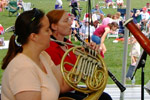
Bach Beethoven and Brunch Classical Music Series in Shadyside's Mellon Park presents free 90-minute classical music concerts. You can buy food on site, or pack your fanciest alfresco meal and take part in the best brunch competition. Courtesy CitiParks
10:30 a.m.
Begin your Sunday of cultural treats at the Bach, Beethoven and Brunch Classical Music Series in Shadyside’s Mellon Park.
Bring a picnic basket of goodies and a blanket and settle in for a 90-minute banquet of classical music. Food also is available for purchase.
But if you’re of a competitive nature, you may want to put some effort into your brunch menu. Each week, there’s a prize for the winner of the best brunch competition.
Presented by CitiParks, this popular event runs every Sunday through Aug. 15 and is free.
Upcoming performances include Pittsburgh Guitar Trio on Sunday and Allegheny Brass Band on July 25.
Details: 412-255-2391 or here
12:30 p.m.
It’s time to satisfy your appetite for visual art.
From Mellon Park head to the Oakland area.
Armed with your trusty Oakland edition of “Pittsburgh Art in Public Places,” begin your walking tour at the memorial fountain designed by Saint-Gaudens near the entrance to Carnegie Library of Pittsburgh.
The walking tour covers a lot of ground, taking you past 26 outdoor sculptures, monuments and statues at sites on the Carnegie Mellon University campus, in Schenley Park, outside of Soldiers and Sailors Memorial Hall and Museum and around Schenley Plaza and the Cathedral of Learning.
The complete walk takes between 75 minutes and two hours, longer if you take rest stops or hydration breaks.
2:30 p.m.
End your tour with a rest stop in Schenley Plaza. Take a spin on the carousel. Refuel with something snacky from one of the food kiosks. Possibilities include bagels and pastries at the Bagel Factory, sushi and bubble-tea drinks from Asia Tea House, gyros and salads from Opa Gyros and pizza rolls, pretzels and vegetarian options from Milky Way.
There’s an abundance of benches or cafe-style tables and chairs throughout the park. If you’re looking for shade, head to the big tent at one end of the park.
Some of you may be willing to call it a successful day out right here.
If you’ve not yet had your fill of art, continue on.
3:30 p.m.
Now, it’s time to explore the North Shore.
Firmly grasping your map of Walking Tour 2: North Shore from “Pittsburgh Art in Public Places: Downtown Walking Tour” begin at the Alcoa Building that faces the water between Sandusky and Anderson streets.
This second tour covers 22 sculptures, architectural wonders and statues that range from the traditional — bronze statues of Art Rooney Sr. and Honus Wagner to George Sugarman’s colorful aluminum abstract sculpture. Along the way you’ll pass long-standing landmarks, such as the former Buhl Planetarium and post office buildings, now re-purposed as the Pittsburgh Children’s Museum in Allegheny Center, and get close-up views of Pittsburgh’s two humongous sports stadiums.
This tour should take between 75 minutes and two hours, depending on how fast you walk and how often you linger.
5:30 p.m.
Dine alfresco at one of the many restaurants along North Shore Drive that offers outdoor dining.
Two possibilities:
• Jerome Bettis’ Grille 36 (412-224-6287 or here) offers a view of the river from beneath the black-and-gold umbrellas in its outdoor dining area. A full menu ranges from bar food and sandwiches to a 36-ounce strip steak served with mushrooms, onions, mashed potatoes and broccoli for $44.95.
• Calico Jack’s Cantina (412-322-7380 or here) also offers a view of the water from its outdoor tables along the restaurant’s northern side. It features a casual menu of Mexican and Cajun bayou dishes.
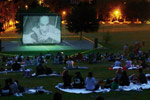
Cinema in the Park, presented on Schenley Park's Flagstaff Hill, offers free showings of recent movies. Courtesy CitiParks
8 p.m.
Finish your day with a movie or a play under the stars.
Each Sunday and Wednesday through Aug. 29, CitiParks’ Dollar Bank Cinema in the Park offers a screening of a recent film at Flagstaff Hill in Schenley Park. Upcoming Sunday films include “Imagine That” (this Sunday), “Astro Boy” (July 25) and “Bandslam” (Aug. 1). It’s part of a larger program that offers outdoor screenings in city parks throughout Pittsburgh.
Admission is free. Screenings begin at dusk.
Details: 412-422-6426 or here.
If you prefer live entertainment and can wait a few weeks, Quantum Theatre will be performing “The Howling Miller” (July 29 to Aug. 22) outdoors in a production that utilizes the burned-out Frick Environmental Center in Squirrel Hill as a background. Set in Lapland in the post-war years, the play revolves around a troubled stranger who is a man, a myth and a stranger who is part hero, part howler.
You’ll need to adjust your dinner plans slightly as Sunday performances begin at 7 p.m., but it’s at 8 p.m. Wednesdays through Saturdays. Admission is $30-$45; $16 for students.
Details: 412-697-2929 or here.
-
Old-Fashioned Amusement Parks Once Beckoned, Have Nearly Vanished
By Bobby Cherry and Kristina Serafini
SEWICKLEY HERALD
Thursday, July 8, 2010
A model of Pittsburgh's Luna Park is one of the attractions at the train exhibit at the Carnegie Science Center, North Side. Opened in 1905, Luna Park in Oakland was known for its performances, odd attractions and, most notably, its use of electricity. Tribune-Review Archives
For more than 100 years, American amusement parks have entertained and thrilled those looking for summertime excitement. But as cultures shifted and competition increased, the thrills, fun and family gatherings at many parks stopped, leaving only memories behind.
From the late 19th century through the mid 1950s, there were almost two dozen such parks in the Pittsburgh area. Few have survived.

Families who went to Kennywood Park packed picnic lunches, which sat undisturbed on tables as folks enjoyed the rides. Rare was the family who bought food at the park. These Ford City picnickers clean up after lunch during the fifth annual Ford City Community Picnic at Kennywood Park. About 6,000 residents of the Ford City area enjoyed a day of fun at the amusement park in June of 1956. Tribune-Review Archives
Luna Park
Opened in 1905, Luna Park in Oakland was known for its performances, odd attractions and, most notably, its use of electricity.
More than 67,000 lights illuminated the park’s attractions situated near Craig Street and what now is Baum Boulevard.
“At the time, most people had one, maybe two lights in their house if they were lucky,” said Jim Futrell, amusement park historian.
Owned by Frederick Ingersoll, an inventor who owned 38 similar parks across the country, Luna Park offered concerts, foreign landmark replicas and rides.
In 1995, Kennywood Park paid homage to Luna by re-creating the Shoot-the-Chutes ride and water fountain features in its Lost Kennywood addition.
Attractions such as Infant Incubator dazzled visitors.
A 1906 brochure for the park advertised, “Little mites of humanity, whose lives were despaired of, were taken to the incubator, where, under the care of learned physicians, and the gentle ministrations of trained nurses, the park patrons saw them grow strong and sturdy again.”
Ingersoll filed for bankruptcy in March 1908. The park closed in August 1909, nearly two years after a lion escaped, killing a visitor.

Inside Storybook Forest at Idlewild Park, Eleanor Clark, of Ligonier Township, portrays the part of the Old Woman who Lives in the Shoe. Getting a hug on their visit are Paige Ohler and her little sister Aerica of Mt. Pleasant. Idlewild Park, which opened in 1878, has to be the oldest continuing amusement park in the Pittsburgh area, if not the country. Tribune-Review Archives
White Swan Park
White Swan Park had everything from roller coasters to skee ball — but not white swans.
“Dad always wanted to put white swans on the lakes in the park,” said Bill Kleeman, son of White Swan Park owners Edward and Margaret Kleeman. The park also was owned by Margaret Kleeman’s brother, Roy Todd.
Like the rest of the park, the lakes are gone. Rides and attractions were torn down nearly 20 years ago as the park was forced to close in 1990 after state Department of Transportation officials relocated the Parkway West to the new Pittsburgh International Airport in Findlay.
The summer of 1989 would be the last for the park, which entertained locals for 34 years.
“Every time I drive past it, I look up and realize I’m driving over White Swan Park,” said Steve Mcateer, who worked most of the rides before becoming a maintenance man for the park in the late 1960s and early 1970s.
“It was a grand old thing. It was like one big family.”
Known for its Galaxy, Mad Mouse and large slide, White Swan Park entertained celebrities heading to and from the airport and children from around the West Hills.
“There was a constant flow of picnics, too,” said Mcateer of North Fayette. “There was always something going on at the park.”

West View Park, opened in 1906, was noted for its community picnics and Danceland, where the Rolling Stones appeared in 1964. Roller coasters were made out of wood and Kiddieland was a big draw for the little ones in the family. Tribune-Review Archives
West View Park
The factors that made West View Park prosper contributed to its demise.
During the beginning of its 71-year run, the park, located on Perrysville Avenue in West View, was a hot spot for community picnics. More than 100 picnics were held there the first season the park opened, according to Heinz History Center archives.
Founded by Theodore M. Harton, West View Park boasted many popular rides — most of which were built by the T.M. Harton Co. — including the Dips, the first coaster built in Pennsylvania with drops of more than 50 feet.
The park was passed down through the Harton family, and though the 1920s started off slow, by the end of the decade, the park had undergone a renovation to add a new roller coaster, the Racing Whippet, to the landscape, as well as several other new rides and renovations to existing ones.
Dancing became a popular pastime in the 1920s, and West View Park’s ballroom provided much of the financial stability during the Great Depression. During the evenings, a capacity-sized crowd often crammed into the dancing pavilion for music from local and national bands, including the Rolling Stones, who played at the center in 1964.
Perhaps the park’s most successful period arrived when George M. Harton III took control in 1945. The next year, three new rides — a miniature railroad, flying skooter and Ferris Wheel — were added. In 1947, the ballroom was renovated to include new lighting and air conditioning and reopened as Danceland in 1948.
Though dancing started losing its popularity in the 1950s, many of the couples who used to dance there were starting to bring their children to the park’s Kiddieland.
But the good times wouldn’t last forever.
In September 1965, the Pittsburgh Railways Company discontinued trolley service to the park. Then, in 1966, George Harton III died, the park was passed on to his 80-year-old mother, and it fell by the wayside.
“The family grew increasingly detached from the park,” said Jim Futrell, amusement park historian.
Without improvements to the park, people began turning to Kennywood Park to host picnics.
West View Park was dealt a major blow on Oct. 3, 1973, when a fire destroyed Danceland. The park closed before the 1978 season.

Alameda Park in Butler County was once an amusement park that opened in 1901. The building at far right in this drawing housed the carousel and is the only original building remaining. Tribune-Review Archives

At one time, train service to amusement parks in the area was common as entire communities or schools spent the day at the park after arriving there by rail. A special train carried more than 1,700 Ford City picnickers to Kennywood Park for an annual community picnic day in 1958. People waited at the railroad station at the corner of Third Avenue and Ford Street at the present site of the town's clock tower to board the train. Tribune-Review Archives

The Steel Phantom coaster at Kennywood Park in West Mifflin makes its way through a corkscrew on Monday, Sept. 4, 2000, the last day of its existence. As time passes, visitors expect more and more -- and bigger, faster and more thrill filled coasters. Parks throughout the country compete to offer riders the latest in coaster technology. AP Photo | Gene J. Puskar
More parks
Many amusement parks opened in the late 19th and early 20th centuries in the Pittsburgh region:
1878 — Idlewild Park, Somerset
1897 — Calhoun Park, Lincoln Place
1898 — Kennywood Park, West Mifflin
1901 — Maple Grove Park, Pittsburgh
1901 — Eldora Park, Eldora
1901 — Alameda Park, Butler
1901– Homestead Park, Homestead
1902 — Oakwood Amusement Park, Crafton
1903 — Southern Park, Carrick
1903 — Oakford Park, Jeannette
1904 — Interurban Park, Pittsburgh
1905 — Luna Park, Oakland
1906 — West View Park, West View
1906 — Dreamland, Pittsburgh
1906 — Coney Island, Neville Island
1906 — Dream City, Wilkinsburg
1924 — Rainbow Gardens, White Oak
1927 — Burkes Glen Park, Monroeville
1927 — Harmarville Park, Blawnox
1928 — Mapleview Park, Canonsburg
1955 — White Swan Park, Findlay
Source: Tribune-Review News Service research
An era that has passedThe turn of the last century “was the time when trolley companies were expanding and opening parks at the ending of the line to generate traffic on evenings and weekends,” said Jim Futrell, author of “Amusement Parks of Pennsylvania” and historian for the National Amusement Park Historical Association in Lombard, Ill.
“They were a much different animal than what parks are today,” he said. “They offered picnics, dances and maybe a roller coaster. It was a much different type of environment than what you see today.”
The number of parks in the region — about two dozen opened between 1878 and 1955 — was uncommon for its size, Futrell said.
“It was a testament to the topography and the industrialized nature of the region that so many parks existed,” Futrell said.
In 1906 alone, four parks opened: West View Park, now a plaza that houses Giant Eagle; Dreamland in Pittsburgh; Coney Island in Neville Island; and Dream City in Wilkinsburg.
White Swan Park — opened in 1955. Situated on the Moon-Findlay border, it was designed as a roadside stop along the Parkway West to the then-Greater Pittsburgh International Airport.
“At the time, people would travel from miles and miles away to drive on the parkway,” said Bill Kleeman of Sewickley, whose parents, Edward and Margaret Kleeman, and uncle, Roy Todd, owned White Swan.
When trolley companies merged into larger entities, many owned multiple amusement parks, such as the Pittsburgh Railways Company that at one time owned Calhoun Park in Lincoln Place, Oakwood in Crafton, Southern Park in Carrick and Kennywood Park in West Mifflin.
The trolley company sold the parks to the Henninger family, who eventually sold or closed three of the four parks. Kennywood opened in 1898 and is among one of the few old-fashioned amusement parks to remain open.
Few records exist from many of the parks in the region, including Coney Island, a short-lived park that opened on Neville Island on June 27, 1907. The park featured a 50-foot boardwalk, shoot-the-chutes ride and a 1,000-foot beach.
The Great Depression threatened the local amusement park industry, leaving a handful of parks, including Kennywood, Idlewild Park and West View, Futrell said.
As time passed, visitors expected more and more, he said.
“The industry was maturing, and people wanted more thrill rides,” Futrell said. “Smaller parks didn’t have space or funds for thrill rides.”
Today, the family-owned amusement park is an anachronism. The region’s last — Kennywood and its sister parks Idlewild Park and Sandcastle Waterpark — were sold in 2007 by longtime owners the Henninger and McSwigan families to Spain-based Parques Reunidos.
-
South Park Middle School Outdoor Classroom to Serve Double Duty
Thursday, July 08, 2010Howard Anderson said his smelly, sometimes boisterous lesson plans don’t do anything for his popularity in the teachers lounge at South Park Middle School.
“We’re dissecting fish and the room stinks or we’re making bottle rockets,” the fifth-grade science teacher said last week as he and a small crew of laborers worked to assemble the wooden structure for an outdoor classroom that he hopes will double as a memorial garden..
Mr. Anderson said he began mulling the concept in May 2009, three months after his friend and fellow science teacher, Marilyn Walsh, died from pancreatic cancer. He said he wanted to honor Mrs. Walsh by creating a lasting memorial combining two of her favorite things: teaching and tiger lilies.
His vision turned into a pet project after he helped secure a $5,000 grant from Lowe’s and a contribution from Consol Energy to fund the facility, which will be located behind the middle school.
But Mr. Anderson said that while he was thankful for the funding, a few thousand dollars doesn’t go far when it comes to building a 20-by-20-foot structure with an asphalt floor and gabled roof.
In fact, he said the project may have faltered without Stephen Bornyas, owner-operator of Bornyas Residential Construction of Boston, who offered to complete the structure for what Mr. Anderson said was a significantly reduced rate.
Mr. Anderson said he reached out to Mr. Bornyas after Internet research led him to a story about the company building a similar outdoor classroom at Elizabeth Forward School District.
Mr. Bornya said he expected the project to take two days for his crew to complete. Gabe Gehenio of Gabriels Excavation also worked at a reduced rate to help.
Once the structure is finished, phase two — installation of a garden hugging the perimeter of the outdoor classroom — will begin.
Mr. Anderson said that he hopes the outdoor classroom will help other teachers add flexibility to their lesson plans and that the space will be used for instruction, as well as a quiet place for members of the community to eat lunch or quietly reflect.
But he was clear: The outdoor classroom is an evolving science project in its own right.
“I don’t want it to end,” he said. “I want it to get bigger and better and improve every year.”
And he said anytime his dedication wavered, he thought of what Mrs. Walsh would have done.
“She inspired me because she came to school sick and she came tired,” Mr. Anderson said, adding that even when the teacher was in the hospital she called to see how her students had fared on their standardized tests.
Mr. Anderson said the memory of Mrs. Walsh has also inspired him to create a horticultural club at the middle school, which will help interested youngsters learn more about the art of cultivating flowers while also ensuring the garden is maintained.
He added that he will be looking for funding to add an alternative energy source. Mr. Anderson said one day he would like to incorporate solar panels or a wind turbine, which would complement both the facility itself, as well as its capacity for educational enrichment.
But until then, he said he looks forward to fall, when he’ll be able to test drive the new classroom.
Anything that smells pretty awful or that concentrates on fire tends to work better outdoors, anyway, Mr. Anderson said.
Middle school principal Kevin Monaghan lauded the project and Mr. Anderson for his creativity at a time when students standardized test scores are often the focus.
“It makes lessons more relative to the students,” Mr. Monaghan said. “Something like this makes all the difference.”

